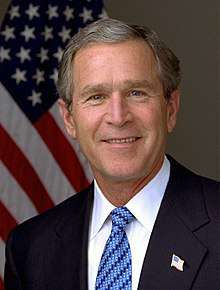John Ashcroft
John David Ashcroft (born May 9, 1942) is an American lawyer, songwriter and former politician who served as the 79th U.S. Attorney General (2001–2005), in the George W. Bush Administration. He later founded The Ashcroft Group, a Washington D.C. lobbying firm.[1]
John Ashcroft | |
|---|---|
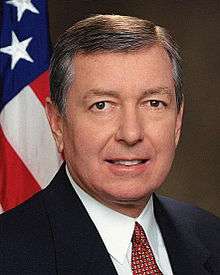 | |
| 79th United States Attorney General | |
| In office February 2, 2001 – February 3, 2005 | |
| President | George W. Bush |
| Deputy | Robert Mueller (acting) Larry Thompson James Comey |
| Preceded by | Janet Reno |
| Succeeded by | Alberto Gonzales |
| United States senator from Missouri | |
| In office January 3, 1995 – January 3, 2001 | |
| Preceded by | John Danforth |
| Succeeded by | Jean Carnahan |
| Chair of the National Governors Association | |
| In office August 20, 1991 – August 4, 1992 | |
| Preceded by | Booth Gardner |
| Succeeded by | Roy Romer |
| 50th Governor of Missouri | |
| In office January 14, 1985 – January 11, 1993 | |
| Lieutenant | Harriett Woods Mel Carnahan |
| Preceded by | Kit Bond |
| Succeeded by | Mel Carnahan |
| 38th Attorney General of Missouri | |
| In office January 10, 1977 – January 14, 1985 | |
| Governor | Joseph Teasdale Kit Bond |
| Preceded by | John Danforth |
| Succeeded by | William L. Webster |
| 29th Auditor of Missouri | |
| In office January 8, 1973 – January 14, 1975 | |
| Governor | Kit Bond |
| Preceded by | Kit Bond |
| Succeeded by | George W. Lehr |
| Personal details | |
| Born | John David Ashcroft May 9, 1942 Chicago, Illinois, U.S. |
| Political party | Republican |
| Spouse(s) | Janet Ashcroft |
| Children | 3, including Jay |
| Education | Yale University (BA) University of Chicago (JD) |
| Signature | |
Ashcroft previously served as Attorney General of Missouri (1976–1985), and as the 50th Governor of Missouri (1985–1993), having been elected for two consecutive terms in succession (a historical first for a Republican candidate in the state), and he also served as a U.S. Senator from Missouri (1995–2001). He had early appointments in Missouri state government and was mentored by John Danforth. He has written several books about politics and ethics. Since 2011 he sits on the board of directors for the private military company Academi (formerly Blackwater), has been a member of the Federalist Society, and is a professor at the Regent University School of Law, a conservative Christian institution affiliated with televangelist Pat Robertson.
His son, Jay Ashcroft, is also a politician, serving as Secretary of State of Missouri since January, 2017.
Early life and education
Ashcroft was born in Chicago, Illinois, the son of Grace P. (née Larsen) and James Robert Ashcroft. The family later lived in Springfield, Missouri, where his father was a minister in an Assemblies of God congregation, served as president of Evangel University (1958–74), and jointly as President of Central Bible College (1958–63). His mother was a homemaker, whose parents had emigrated from Norway.[2] His paternal grandfather was an Irish immigrant.[3]
Ashcroft graduated from Hillcrest High School in 1960.[4] He attended Yale University, where he was a member of the St. Elmo Society, graduating in 1964. He received a Juris Doctor degree from the University of Chicago School of Law (1967).[5]
After law school, Ashcroft briefly taught Business Law and worked as an administrator at Southwest Missouri State University. During the Vietnam War, he was not drafted because he received six student draft deferments and one occupational deferment because of his teaching work.[6][7]
Political career
Missouri State Auditor
In 1972, Ashcroft ran for a Congressional seat in southwest Missouri in the Republican primary election, narrowly losing to Gene Taylor. After the primary, Missouri Governor Kit Bond appointed Ashcroft to the office of State Auditor, which Bond had vacated when he became governor.
In 1974, Ashcroft was narrowly defeated for election to that post by Jackson County County Executive George W. Lehr. He had argued that Ashcroft, who is not an accountant, was not qualified to be the State Auditor.
Attorney General of Missouri
.jpg)
Missouri Attorney General John Danforth, who was then in his second term, hired Ashcroft as an Assistant State Attorney General. During his service, Ashcroft shared an office with Clarence Thomas, a future U.S. Supreme Court Supreme Court Justice. (In 2001, Thomas administered Ashcroft's oath of office as U.S. Attorney General.)
In 1976, Danforth was elected to the U.S. Senate, and Ashcroft was elected to replace him as State Attorney General. He was sworn in on December 27, 1976. In 1980, Ashcroft was re-elected with 64.5 percent of the vote, winning 96 of Missouri's 114 counties.[8]
In 1983, Ashcroft wrote the leading amicus curiae brief in the U.S. Supreme Court Case Sony Corp. of America v. Universal City Studios, Inc., supporting the use of video cassette recorders for time shifting of television programs.[9]
Governor of Missouri (1985–1993)
_(cropped).jpg)
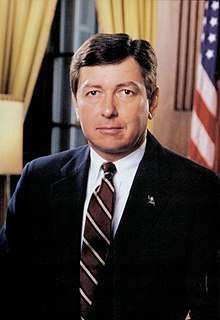
Ashcroft was elected governor in 1984 and re-elected in 1988, becoming the first (and, to date, the only) Republican in Missouri history elected to two consecutive terms.

In 1984, his opponent was the Democratic Lt. Governor Ken Rothman. The campaign was so negative on both sides that a reporter described the contest as "two alley cats [scrapping] over truth in advertising". In his campaign ads, Ashcroft showed the contrast between his rural-base and the supporters of his urban-based opponent from St. Louis. Democrats did not close ranks on primary night. The defeated candidate Mel Carnahan endorsed Rothman. In the end, Ashcroft won 57 percent of the vote and carried 106 counties—then the largest Republican gubernatorial victory in Missouri history.[8]
In 1988, Ashcroft won by a larger margin over his Democratic opponent, Betty Cooper Hearnes, the wife of the former governor Warren Hearnes. Ashcroft received 64 percent of the vote in the general election—the largest landslide for governor in Missouri history since the U.S. Civil War.[10]
During his second term, Ashcroft served as chairman of the National Governors Association (1991–92).
As governor, Ashcroft helped enact tougher standards and sentencing for gun crimes, increased funding for local law enforcement, and tougher standards and punishment for people bringing guns into schools. While Ashcroft was in office:
- The number of full-time law enforcement officers in Missouri increased 3,825 (63%) from 1985 to 1992.
- Capacity at Missouri prisons increased by 72% from 9,071 in 1985 to 15,630 in 1993.
- Missouri was above average in the length of time criminals had to serve for all sentences according to Gail Hughes, deputy director for the state Corrections Department, citing the 1991 yearbook published by the Criminal Justice Institute. The national average for time served for all crimes was 23.7 months, while in Missouri the average length of a sentence was 28.9 months.
- According to the U.S. Department of Justice, prison time in Missouri as a percentage of the time sentenced to jail was 73% in 1993 and increased to 86% in 1997.
- The number of juveniles arrested for committing a crime increased by 16.3% between 1985 and 1992.
- Though Ashcroft initially opposed the legislation as governor, the Missouri legislature enacted its first hate crimes legislation.[11]
- The legislature enacted the Missouri Victim's Bill of Rights, which allows crime victims to be informed of and present at criminal proceedings, the right to restitution, the right to protection from the defendant and the right to be informed of the escape or release of a defendant.
U.S. Senator from Missouri
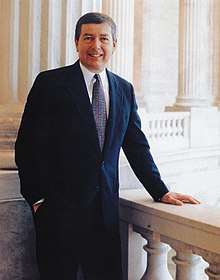
In 1994 Ashcroft was elected to the U.S. Senate from Missouri, again succeeding John Danforth, who retired from the position. Ashcroft won 59.8% of the vote against Democratic Congressman Alan Wheat. As Senator:
- He opposed the Clinton Administration's Clipper encryption restrictions.
- In 1999, as chair of the Senate's subcommittee on patents, he helped extend patents for several drugs, most significantly the allergy medication Claritin, to prevent the marketing of less-expensive generics.[12]
- On March 30, 2000, with Senator Russ Feingold, Ashcroft convened the only Senate hearing on racial profiling. He said the practice was unconstitutional and that he supported legislation requiring police to keep statistics on their actions.
In 1998, Ashcroft briefly considered running for U.S. President; but on January 5, 1999, he announced that he would not seek the presidency and would defend his Senate seat in the 2000 election.[13]
In the Republican primary, Ashcroft defeated Marc Perkel.[14] In the general election, Ashcroft faced a challenge from Governor Mel Carnahan.
In the midst of a tight race, Carnahan died in an airplane crash three weeks prior to the election. Ashcroft suspended all campaigning after the plane crash. Because of Missouri state election laws and the short time to election, Carnahan's name remained on the ballot. Lieutenant Governor Roger B. Wilson became governor upon Carnahan's death. Wilson said that should Carnahan be elected, he wanted to appoint his widow, Jean Carnahan, to serve in her husband's place; Mrs. Carnahan announced that, in accordance with her late husband's goal, she would serve in the Senate if voters elected his name. Following these developments, Ashcroft resumed campaigning.[15]
Carnahan won the election 51% to 49%. No one had ever posthumously won election to the Senate, though voters had on at least three occasions chosen deceased candidates for the House of Representatives.[16] Ashcroft also has the unique distinction of being the only incumbent U.S. Senator defeated for re-election by a dead person.[17]
U.S. Attorney General

In December 2000, following his Senatorial defeat, Ashcroft was chosen for the position of U.S. attorney general by president-elect George W. Bush. He was confirmed by the Senate by a vote of 58 to 42, with most Democratic senators voting against him, citing his prior opposition to using forced busing to achieve desegregation, and their opposition to Ashcroft's anti-abortionism. At the time of his appointment he was known to be a member of the Federalist Society.[18]
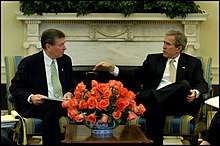
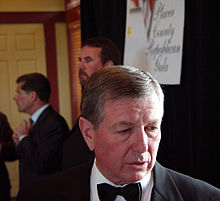
In May 2001, the FBI revealed that they had misplaced thousands of documents related to the investigation of the Oklahoma City bombing. Ashcroft granted a 30-day stay of execution for Timothy McVeigh, the man convicted and sentenced to death for the bombing.
After the September 11, 2001 attacks in the United States, Ashcroft was a key administration supporter of passage of the USA Patriot Act. One of its provisions, Section 215, allows the Federal Bureau of Investigation (FBI) to apply for an order from the Foreign Intelligence Surveillance Court to require production of "any tangible thing" for an investigation. This provision was criticized by citizen and professional groups concerned about violations of privacy. Ashcroft referred to the American Library Association's opposition to Section 215 as "hysteria" in two separate speeches given in September 2003.[19][20] While Attorney General, Ashcroft consistently denied that the FBI or any other law enforcement agency had used the Patriot Act to obtain library circulation records or those of retail sales. According to the sworn testimony of two FBI agents interviewed by the 9/11 Commission, Ashcroft ignored warnings of an imminent al-Qaida attack.[21]
In 2002, under Ashcroft, curtains were installed blocking the Spirit of Justice statue in the Robert F. Kennedy Department of Justice Building, which is of a woman wearing a toga-like dress with one breast revealed, from view during speeches.[22] The curtains were first used on a rental basis during the administration of Dick Thornburgh.[23] Justice officials long insisted that the curtains were put up to improve the room's use as a television backdrop and that Ashcroft had nothing to do with it. Ashcroft's successor, Alberto Gonzales, removed the curtains in June 2005.[24] Ashcroft also held daily prayer meetings.[22]
In March 2004, the Justice Department under Ashcroft ruled that the President Bush's domestic intelligence program—code name Stellar Wind—was illegal;[25] some time after the ruling, Ashcroft became critically ill with acute pancreatitis. President Bush's White House Counsel, Alberto Gonzales, and his Chief of Staff, Andrew Card Jr., went to Ashcroft's bedside in the hospital intensive-care unit, to persuade the incapacitated Attorney General to sign a document to "reauthorize" the program that Justice had declared illegal and at end.[25] According to his account before the Senate Judiciary Committee, Acting Attorney General James Comey alerted then-FBI Director Robert Mueller III of the reauthorization plan, and "raced" to the hospital, "sirens blaring" , arriving ahead of Gonzales and Card, Jr.[25] Ashcroft, "summoning the strength to lift his head and speak", refused to sign;[25] by his description in interview, Jack Goldsmith, head of the Office of Legal Counsel for Justice, was also there to support Ashcroft,[26] as was Patrick Philbin, an Associate Deputy Attorney General (according to congressional testimony from Comey).[27] FBI Director Robert Mueller, who also was rushing to the hospital, spoke by phone to Ashcroft's security detail, ordering them not to allow Card or Gonzales to have Comey removed from the hospital room.
Following accounts of the Abu Ghraib torture and prisoner abuse scandal in Iraq, one of the Torture memos was leaked to the press in June 2004. Jack Goldsmith, then head of the Office of Legal Counsel, had already withdrawn the Yoo memos and advised agencies not to rely on them. After Goldsmith was forced to resign because of his objections, Attorney General Ashcroft issued a one paragraph opinion re-authorizing the use of torture.[28][29]
On November 9, 2004, following George W. Bush's re-election, Ashcroft announced his resignation,[30] which took effect on February 3, 2005, after the Senate confirmed White House Counsel Alberto Gonzales as the next attorney general.[31] Ashcroft said in his hand-written resignation letter, dated November 2, "The objective of securing the safety of Americans from crime and terror has been achieved."[32]
Consultant and lobbyist
In May 2005, Ashcroft laid the groundwork for a strategic consulting firm, The Ashcroft Group, LLC.[33] He started operation in the fall of 2005 and as of March 2006 had twenty-one clients, turning down two for every one accepted.[34] In 2005 year-end filings, Ashcroft's firm reported collecting $269,000, including $220,000 from Oracle Corporation, which won Department of Justice approval of a multibillion-dollar acquisition less than a month after hiring Ashcroft. The year-end filing represented, in some cases, only initial payments.
According to government filings, Oracle is one of five Ashcroft Group clients that seek help in selling data or software with security applications. Another client, Israel Aircraft Industries International, is competing with Seattle's Boeing Company to sell the government of South Korea a billion dollar airborne radar system.[35]
In March 2006, The New York Times reported that Ashcroft had positioned himself as an "anti-Abramoff." In an hour-long interview, Ashcroft used the word integrity scores of times.[34] In May 2006, based on conversations with members of Congress, key aides and lobbyists, The Hill magazine listed Ashcroft as one of the top 50 "hired guns" (lobbyists) that K Street had to offer.[36]
In August 2006, the Washington Post reported that Ashcroft's firm had 30 clients, many of which made products or technology aimed at homeland security. The firm had not disclosed about a third of its client list on grounds of confidentiality. The firm also had equity stakes in eight client companies. It reported receiving $1.4 million in lobbying fees in the past six months, a small fraction of its total earnings.[37]
After the proposed merger of Sirius Satellite Radio Inc. and XM Satellite Radio Holdings Inc., Ashcroft offered the firm his consulting services, according to a spokesman for XM.[38] The spokesman said XM declined Ashcroft's offer. Ashcroft was subsequently hired by the National Association of Broadcasters, which is strongly opposed to the merger.
In 2011, Ashcroft became an “independent director” on the board of Xe Services (now Academi), the controversial private military company formerly known as Blackwater (Nisour Square massacre), which faced scores of charges related to weapons trafficking, unlawful force, and corruption[39] had named Ted Wright as CEO in May 2011.[40] Wright hired a new governance chief to oversee ethical and legal compliance and established a new board composed of former government officials, including former White House counsel Jack Quinn and Ashcroft.[41] In December 2011, Xe Services rebranded to Academi to convey a more "boring" image.[42][43][44][45]
The firm also has a law firm under its umbrella, called the Ashcroft Law Firm.[46] In December 2014, the law firm was hired by convicted Russian arms trafficker Viktor Bout to overturn his 2011 conviction.[47]
In June 2017, Ashcroft was hired by the government of Qatar to carry out a compliance and regulatory review of Qatar's anti-money laundering and counter-terrorist financing framework, to help challenge accusations of supporting terrorism by its neighbors, following a regional blockade, as well as claims by U.S. President Donald Trump.[48][49][50][51]
In June 2018, it is reported that Ashcroft was hired by Najib Razak among other top U.S lawyers to defend him in the 1MDB scandal, back in 2016. According to the document, the firm was hired to provide legal advice and counsel to Najib regarding "improper actions by third parties to attempt to destabilise the government of Malaysia". Although it is unsure whether Najib will retain the services of Ashcroft on the issue due to the United States Department of Justice's probe into 1MDB.[52]
Political issues
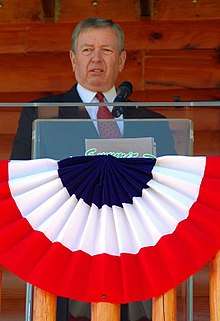


In January 2002, the partially nude female statue of the Spirit of Justice, which stands in the Great Hall of the Justice Department, where Ashcroft held press conferences, was covered with blue curtains, along with its male counterpart, the Majesty of Justice. Some speculated that Ashcroft thought that reporters were photographing him with the female statue in the background to make fun of his church's opposition to pornography. A Justice Department spokeswoman said that Ashcroft knew nothing of the decision to spend $8,000 for the curtains; a spokesman said the decision for permanent curtains was intended to save on the $2,000 per use rental costs of temporary curtains used for formal events.[53]
In July 2002, Ashcroft proposed the creation of Operation TIPS, a domestic program in which workers and government employees would inform law enforcement agencies about suspicious behavior they encounter while performing their duties. The program was widely criticized from the beginning, with critics deriding the program as essentially a Domestic Informant Network along the lines of the East German Stasi or the Soviet KGB,[54][55] and an encroachment upon the First and Fourth amendments. The United States Postal Service refused to be a party to it. Ashcroft defended the program as a necessary component of the ongoing War on Terrorism, but the proposal was eventually abandoned.[56]
Ashcroft proposed a draft of the Domestic Security Enhancement Act of 2003, legislation to expand the powers of the U.S. government to fight crime and terrorism, while simultaneously eliminating or curtailing judicial review of these powers for incidents related to domestic terrorism.[57] The bill was leaked and posted to the Internet on February 7, 2003.
On May 26, 2004, Ashcroft held a news conference at which he said that intelligence from multiple sources indicated that the terrorist organization, al Qaeda, intended to attack the United States in the coming months.[58] Critics suggested he was trying to distract attention from a drop in the approval ratings of President Bush, who was campaigning for re-election.[59]
Groups supporting individual gun ownership praised Ashcroft's support through DOJ for the Second Amendment. He said specifically, "the Second Amendment protects an individual's right to keep and bear arms," expressing the position that the second amendment expresses a right.[60]
In 2009 in Ashcroft v. al-Kidd, the Ninth Circuit Court of Appeals in San Francisco found that Ashcroft could be sued and held personally responsible for the wrongful detention of Abdullah al-Kidd. The American citizen was arrested at Dulles Airport in March 2003 on his way to Saudi Arabia for study. He was held for 15 days in maximum security in three states, and 13 months in supervised release, to be used as a material witness in the trial of Sami Omar Al-Hussayen. (The latter was acquitted of all charges of supporting terrorism). Al-Kidd was never charged and was not called as a witness in the Al-Hussayen case.)[61]
The panels court described the government's assertions under the USA Patriot Act (2001) as "repugnant of the Constitution". In a detailed and at times passionate opinion, Judge Milan Smith likened allegations against al-Kidd as similar to the repressive practices of the British Crown that sparked the American Revolution. He wrote that the government asserts it can detain American citizens "not because there is evidence that they have committed a crime, but merely because the government wishes to investigate them for possible wrongdoing".[62] He called it "a painful reminder of some of the most ignominious chapters of our national history".[63]
Abdullah Al-Kidd was held in a maximum security prison for 16 days, and in supervised release for 13 months. Al-Kidd was born Lavoni T. Kidd in 1973 in Wichita, Kansas.[61] When he converted to Islam as a student at the University of Idaho, where he was a prominent football player, he changed his name. He asserts that Ashcroft violated his civil liberties as an American citizen, as he was treated like a terrorist and not allowed to consult an attorney. Al-Kidd's lawyers say Ashcroft, as US Attorney General, encouraged authorities after 9/11 to arrest potential suspects as material witnesses when they lacked probable cause to believe the suspects had committed a crime.[64]
The US Supreme Court agreed on October 18, 2010 to hear the case. On May 31, 2011, the US Supreme Court unanimously overturned the lower court's decision, saying that al-Kidd could not personally sue Ashcroft, as he was protected by limited immunity as a government official.[65][66] A majority of the justices held that al-Kidd could not have won his case on the merits, because Ashcroft did not violate his Fourth Amendment rights.[67]
Ashcroft has been a proponent of the War on Drugs.[68] In a 2001 interview on Larry King Live, Ashcroft announced his intention to escalate efforts in this area.[69] In 2003, Ashcroft and John B. Brown, the acting DEA Administrator, announced a series of indictments resulting from two nationwide investigations code-named Operation Pipe Dream and Operation Headhunter. The investigations targeted businesses selling drug paraphernalia, mostly for cannabis use, under a little-used statute (Title 21, Section 863(a) of the U.S. Code).[70]
Tommy Chong, a counterculture icon, was one of those charged, for his part in financing and promoting Chong Glass/Nice Dreams, a company started by his son Paris. Of the 55 individuals charged as a result of the operations, only Chong was given a prison sentence after conviction (nine months in a federal prison, plus forfeiting $103,000 and a year of probation). The other 54 individuals were given fines and home detentions. While the DOJ denied that Chong was treated any differently from the other defendants, critics thought the government was trying to make an example of him. Chong's experience as a target of Ashcroft's sting operation is the subject of Josh Gilbert's feature-length documentary a/k/a Tommy Chong, which premiered at the 2005 Toronto International Film Festival. In a pre-sentencing brief, the Department of Justice specifically cited Chong's entertainment career as a consideration against leniency.[71]
When Karl Rove was being questioned in 2005 by the FBI over the leak of a covert CIA agent's identity in the press (the Valerie Plame affair), Ashcroft was allegedly briefed about the investigation. The Democratic U.S. Representative John Conyers described this as a "stunning ethical breach that cries out for an immediate investigation." Conyers, the ranking Democrat on the House Judiciary Committee, asked, in a statement, for a formal investigation of the time between the start of Rove's investigation and John Ashcroft's recusal.[72]
Since his service in government, Ashcroft has continued to oppose proposals for physician-assisted suicide, which some states have passed by referenda. When interviewed about it in 2012, when a case had reached the US Supreme Court after California voters had approved a law to permit it under regulated conditions, he said,
I certainly believe that people who are in pain should be helped and assisted in every way possible, that the drugs should be used to mitigate their pain but I believe the law of the United States of America which requires that drugs not be used except for legitimate health purposes.[73]
In 2015, Human Rights Watch called for the investigation of Ashcroft "for conspiracy to torture as well as other crimes."[74]
Personal life

Ashcroft is a member of the Assemblies of God church. He is married to Janet E. Ashcroft and has three children with her.[75] His son, Jay, is the Missouri Secretary of State.[76]
Ashcroft had long enjoyed inspirational music and singing. In the 1970s, he recorded a gospel record entitled Truth: Volume One, Edition One, with the Missouri legislator Max Bacon, a Democrat.[77]
With fellow U.S. senators Trent Lott, Larry Craig, and Jim Jeffords, Ashcroft formed a barbershop quartet called The Singing Senators. The men performed at social events with other senators.
Ashcroft composed a paean titled "Let the Eagle Soar," which he sang at the Gordon-Conwell Theological Seminary in February 2002. Ashcroft has written and sung a number of other songs. He has collected these on compilation tapes, including In the Spirit of Life and Liberty and Gospel (Music) According to John. In 1998, he wrote a book with author Gary Thomas titled Lessons from a Father to His Son.[78]
Ashcroft was given an honorary doctorate before giving the commencement at Toccoa Falls College in 2018.[79]
Books
Representation in other media
- His song, "Let the Eagle Soar", was satirically featured in Michael Moore's 2004 movie Fahrenheit 9/11 and has been frequently mocked by comedians such as David Letterman, Stephen Colbert and David Cross, to name a few.
- The song was performed at Bush's 2005 inauguration by Guy Hovis, a former cast member of The Lawrence Welk Show.
- "Let the Eagle Soar" is heard in the background in the 2015 film The Big Short, as an ironic juxtaposition of schmaltzy music and new-age capitalist sensibility when a phone call is placed to pastoral Boulder, Colorado, where anti-authoritarian ex-banking trader Ben Rickert (played by Brad Pitt) lives.
- The song “Caped Crusader” off of Jello Biafra and The Melvins’ 2004 album “Never Breathe What You Can't See” lifts several lines from Ashcroft and 9/11 hijacker Mohamed Atta in a satirical attack on religious fundamentalism.
References
- Wayne, Leslie (March 17, 2006). "Same Washington, Different Office". The New York Times. Retrieved February 22, 2019.
- Reitwiesner, William Addams. "Ancestry of John Ashcroft". Wargs.com. Retrieved May 28, 2011.
- Toobin, Jeffrey. "Ashcroft's Ascent". The New Yorker. Retrieved July 22, 2020.
- "Ashcroft, John David – Biographical Information". Bioguide.congress.gov. Retrieved May 28, 2011.
- Robbins, Tom (August 17, 2004). "The Sunshine Patriots". Village Voice. Retrieved February 22, 2019.
- Herbert, Bob (August 27, 2004). "Where Is The Shame?". The New York Times. Retrieved August 20, 2018.
- Yarwood, Dean L.; Hardy, Richard J. (1989). "The Norm of Standing Aside: Gubernatorial Transition in Missouri in 1984". In Beyle, Thad L. (ed.). Gubernatorial Transitions: The 1983 and 1984 Elections. Duke University Press. p. 73. ISBN 0-8223-0858-4.
- Sony Corp. of America v. Universal City Studios, Inc., 464 U.S. 417 (U.S. 1984).
- Mullaney, Marie Marmo (1994). Biographical directory of the governors of the United States, 1988–1994. Greenwood Press. p. 217. ISBN 0-313-28312-5.
- CTI Reviews (October 17, 2016). Elder Law. Cram101. p. 16. ISBN 978-1-4672-8156-0.
- Shapiro, Bruce (January 16, 2001). "Can John Ashcroft be stopped?". Salon.com. Archived from the original on May 23, 2009. Retrieved May 28, 2011.
- "Ashcroft decides not to jump into 2000 race". Cnn.com. January 5, 1999. Retrieved May 28, 2011.
- "Ashcroft, Carnahan take sizable leads". Kansas City Star. August 9, 2000. Archived from the original on April 19, 2019 – via NewsBank.
With more than 60 percent of the precincts reporting, Ashcroft, a Republican, had captured 90 percent of the vote, to 10 percent for Marc Perkel of Springfield. Carnahan, a Democrat, had 79 percent of the vote to 21 percent for Ronald Wagganer of St. Louis.
- Lewis, Neil A. (October 31, 2000). "In Missouri, Campaign Flourishes After the Death of the Candidate". The New York Times. Retrieved October 19, 2011.
- "Republican senator loses to dead rival in Missouri". CNN.com. August 30, 2000. Archived from the original on April 18, 2012. Retrieved June 12, 2012.
- Bump, Philip (October 1, 2014). "Five people have won election to Congress, despite being dead". The Washington Post. Retrieved February 22, 2019.
- Edsall, Thomas B. (April 18, 2001). "Federalist Society Becomes a Force in Washington". Washington Post. Retrieved August 17, 2019.
- Ashcroft, John & DOJ Staff (September 15, 2003). "Prepared Remarks of Attorney General John Ashcroft: The Proven Tactics in the Fight against Crime". Washington, D.C.: Justice.gov. Retrieved May 28, 2011.
- Ashcroft, John & DOJ Staff (September 18, 2003). "Remarks of Attorney General John Ashcroft: Protecting Life and Liberty". Memphis, TN: Justice.gov. Retrieved May 28, 2011.
- Myers, Lisa (June 22, 2005). "Did Ashcroft brush off terror warnings?". NBC News. Retrieved October 3, 2014.
- Borger, Julian (March 4, 2002). "Staff cry poetic injustice as singing Ashcroft introduces patriot games". The Guardian. London: Guardian. Retrieved May 28, 2011.
- USA Today Staff (June 24, 2005). "Drapes removed from Justice Department statue". USAToday.com. Associated Press. Retrieved February 22, 2019.
- Sherman, Mark (June 25, 2005). "'Spirit of Justice' statue exposed in all her glory". The Associated Press.
- Eggen, Dan & Kane, Paul (May 16, 2007). "Gonzales Hospital Episode Detailed". ISSN 0190-8286. Retrieved January 30, 2020.CS1 maint: uses authors parameter (link)
- Moyers, Bill & Goldsmith, Jack (September 7, 2007). "Bill Moyers talks with Jack Goldsmith" (transcript). Bill Moyers Journal.CS1 maint: multiple names: authors list (link)
- Auchenbach, Joel (May 16, 2007). "Waterboarding Ashcroft". Washington Post. Archived from the original on September 7, 2008. Retrieved May 23, 2007.
- Savage, Charlie (December 9, 2014). "Reaction to C.I.A. Torture Report—1:58 P.M. The One-Paragraph Torture Memo". The New York Times. Archived from the original on April 13, 2019. Retrieved December 9, 2014.
After senior administration officials gave permission to the C.I.A. to use all previously approved "enhanced" interrogation techniques except waterboarding, Mr. Ashcroft sent a one-paragraph memo to the agency stating that it would be lawful to use those techniques on Mr. Gul. This memo, the report said, simply stated that conclusion and contained no legal analysis to support its claim.
- Shapiro, Ari (July 17, 2008). "Ashcroft Defends Actions On Torture Memos". NPR. Retrieved May 27, 2018.
- King, John (November 9, 2004). "Ashcroft, Evans resign from Cabinet". CNN.com. Archived from the original on October 27, 2008.
- Lewis, Libby (February 3, 2005). "Senate Confirms Gonzales as Attorney General". NPR.org. Retrieved May 28, 2011.
- Ashcroft, John (November 9, 2004). "Ashcroft Resignation Letter". Archived from the original on March 5, 2016. Retrieved May 28, 2011 – via NBCNews.com.
- Michael Sullivan. "The Ashcroft Group, LLC website". Ashcroftgroupllc.com. Retrieved May 28, 2011.
- Wayne, Leslie (March 17, 2006). "Same Washington, Different Office; John Ashcroft Sets Up Shop As Well-Connected Lobbyist". The New York Times. Retrieved May 28, 2011.
- Orlowski, Andrew (January 11, 2006). "Oracle helps Ashcroft board the terror gravy train". The Register. Retrieved August 19, 2018.
- "The sharpest shooters on K Street". The Hill. May 3, 2006. Archived from the original on October 30, 2006. Retrieved August 17, 2018.
- Nakashima, Ellen (August 12, 2006). "Ashcroft Finds Private-Sector Niche". The Washington Post. p. 2. Retrieved February 22, 2019.
- Boles, Corey (March 3, 2007). "Ashcroft Offered His Services to XM Before Being Hired by NAB, XM Says". The Wall Street Journal. Retrieved July 26, 2007.
- "Former AG John Ashcroft joins company once known as Blackwater". OregonLive.com. Associated Press. May 4, 2011. Retrieved January 31, 2020.
- "Company Once Known as Blackwater Names New CEO". Boston.com. Associated Press. June 1, 2011. Retrieved May 29, 2019.
- Hodge, Nathan (September 29, 2011). "Contractor Tries to Shed Blackwater Past". wsj.com. wsj.com. Retrieved September 30, 2011.
- Axelrod, Alan (December 27, 2013). Mercenaries: A Guide to Private Armies and Private Military Companies. p. 432. ISBN 9781483364674.
- "Former Blackwater firm renamed again". BBC News. December 12, 2011. Retrieved December 12, 2011.
- "Academi Board of Directors: John Ashcroft". academi.com. n.d. Archived from the original on January 9, 2012. Retrieved August 17, 2018.
- "Leadership". Constellis. Retrieved May 29, 2019.
- "John Ashcroft". Ashcroft Law Firm. Retrieved October 14, 2016.
- Stempel, Jonathan (December 5, 2014). "Arms dealer Bout seeks new trial, hires Ashcroft law firm". Reuters. Retrieved April 1, 2016.
- Chiacu, Doina; Gibson, Ginger (June 10, 2017). "Qatar, accused of supporting terrorism, hires ex-U.S. attorney general". Reuters. Retrieved June 10, 2017.
- "Qatar blockade: Iran sends five planeloads of food - BBC News". BBC News. June 11, 2017. Retrieved June 11, 2017.
- "Qatar Hires Former U.S. Attorney General To Rebut Terrorism Allegations". RFERL. Retrieved June 10, 2017.
- Allison, Bill (June 10, 2017). "Singled Out by Trump, Qatar Hires Former Top U.S. Law Man". BloombergPolitics. Retrieved June 10, 2017.
- "Najib hires top American lawyers, including former US A-G". TheStar. June 3, 2018. Retrieved June 3, 2018.
- "Curtains for semi-nude justice statue". BBC News. January 29, 2002. Retrieved May 28, 2011.
- Editorial Board (August 4, 2007). "Ashcroft vs. Americans". Common Dreams. Retrieved August 17, 2018.
- Doherty, Brian (July 16, 2002). "An American Stasi". Reason. Retrieved August 17, 2018.
- Giroux HA (2003). The Abandoned Generation: Democracy beyond the Culture of Fear. Basingstoke: Palgrave Macmillan. p. 7. ISBN 1-4039-6138-7. Retrieved August 19, 2018.
- Robert P. Abele (2005). A user's guide to the USA Patriot Act and beyond. Washington, D.C: University Press of America. ISBN 0-7618-3058-8.
- Arena, Kelli; Bohn, Kevin; Frieden, Terry; Meserve, Jeanne; Starr, Barbara (May 26, 2004). "Ashcroft: Al Qaeda intends to attack U.S." CNN.com. Retrieved March 14, 2008.
- Mintz, John; Allen, Mike (June 27, 2004). "Homeland Security, a Politicized Issue: To Suspicious Candidates, the Threat of Attack Is No Longer Above the Fray". The Washington Post. Retrieved August 17, 2018.
- "Archived copy" (PDF). Archived from the original (PDF) on April 13, 2008. Retrieved April 7, 2008.CS1 maint: archived copy as title (link)"Letter to National Rifle Association, May 17, 2001"
- Barnes, Robert (October 18, 2012). "Supreme Court to decide whether Ashcroft can be sued by detained citizen". The Washington Post. Retrieved January 17, 2013.
- "John Ashcroft can be sued for wrongful detention". Sydney Morning Herald. September 5, 2009. Retrieved March 16, 2010.
- Schwartz, John (September 4, 2009). "Panel Rules Against Ashcroft in Detention Case". New York Times. Retrieved April 4, 2013.
- Bravin, Jess (October 18, 2010). "Justices to Hear Ashcroft Appeal". Wall Street Journal. Retrieved October 19, 2010.
- Savage, David G. (May 31, 2011). "Supreme Court tosses out lawsuit accusing John Ashcroft of misusing his power". Chicago Tribune. Retrieved June 9, 2011.
- Epstein, Jennifer (May 31, 2011). "Supreme Court: Abdullah al-Kidd can't sue John Ashcroft over 9/11 arrest". Politico. Retrieved June 9, 2011.
- Klein, Kent (June 1, 2011). "Supreme Court: US Muslim Cannot Sue Former Official". Voice of America. Retrieved January 31, 2020.
- "US: Violence, Teen Drug Use Are Ashcroft Priorities". Mapinc.org. February 8, 2001. Retrieved May 28, 2011.
- "CNN Transcript – Larry King Live: "John Ashcroft Discusses His New Job as Attorney General"". Cnn.com. February 7, 2001. Retrieved May 28, 2011.
- "WAIS Document Retrieval" (PDF). Retrieved May 28, 2011.
- Sullum, Jacob (January 16, 2009). "Bongs Away!". Reason. Retrieved May 29, 2019.
- Waas, Murray S. (August 9, 2005). "What Now, Karl?". Village Voice. Retrieved August 17, 2018.
- "Attorney General Ashcroft Asks Supreme Court To Ban Assisted Suicide". California Healthline. April 16, 2012. Retrieved August 17, 2018.
- "No More Excuses: A Roadmap to Justice for CIA Torture". hrw.org. Human Rights Watch. December 1, 2015. Retrieved December 2, 2015.
- Austin, Shelbi (June 8, 2017). "10 Things You Didn't Know About John Ashcroft". U.S. News & World Report. Archived from the original on September 15, 2017. Retrieved February 22, 2019.
- Palermo, Gregg (November 8, 2016). "Jay Ashcroft wins Secretary of State race". KTVI. Retrieved May 29, 2019.
- "John Ashcroft Sings: Ashcroft & Bacon Gospel Album: TRUTH Volume One, Edition One". Whitehouse.Org. Archived from the original on July 5, 2008. Retrieved May 28, 2011.
- Ashcroft, John (1998). Lessons from a Father to His Son. Thomas Nelson Inc. ISBN 9781418559441.
- "2018 Graduation Ceremony Concludes".
- Melissa Block (October 2, 2006). "Ashcroft Reflects on War on Terrorism". NPR All Things Considered. Retrieved August 1, 2014.
External links
| Wikimedia Commons has media related to John Ashcroft. |
| Wikiquote has quotations related to: John Ashcroft |
- United States Congress. "John Ashcroft (id: A000356)". Biographical Directory of the United States Congress.
- BBC News' John Ashcroft profile
- CNN video of John Ashcroft singing "Let the Eagle Soar"
- Excerpts from an album Ashcroft recorded in the 1970s
- Ashcroft's Senate voting record
- Transcript of James Comey's testimony before the Senate Judiciary Committee, May 15, 2007
- Appearances on C-SPAN
| Political offices | ||
|---|---|---|
| Preceded by Kit Bond |
Auditor of Missouri 1973–1975 |
Succeeded by George Lehr |
| Governor of Missouri 1985–1993 |
Succeeded by Mel Carnahan | |
| Preceded by Booth Gardner |
Chair of the National Governors Association 1991–1992 |
Succeeded by Roy Romer |
| Legal offices | ||
| Preceded by John Danforth |
Attorney General of Missouri 1977–1985 |
Succeeded by William Webster |
| Preceded by Janet Reno |
United States Attorney General 2001–2005 |
Succeeded by Alberto Gonzales |
| Party political offices | ||
| Preceded by Kit Bond |
Republican nominee for Governor of Missouri 1984, 1988 |
Succeeded by William Webster |
| Preceded by Mike Hayden |
Chair of the Republican Governors Association 1989–1990 |
Succeeded by Carroll Campbell |
| Preceded by John Danforth |
Republican nominee for U.S. Senator from Missouri (Class 1) 1994, 2000 |
Succeeded by Jim Talent |
| U.S. Senate | ||
| Preceded by John Danforth |
United States Senator (Class 1) from Missouri 1995–2001 Served alongside: Kit Bond |
Succeeded by Jean Carnahan |




